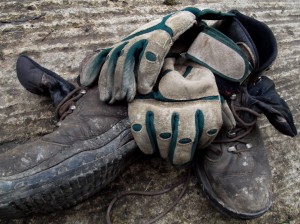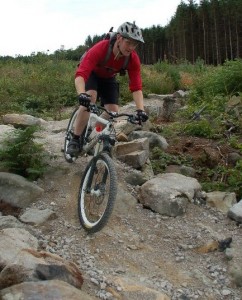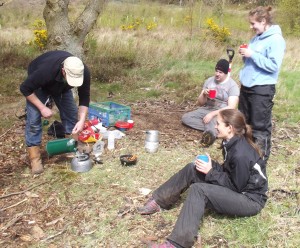Two years ago, give or take, I first rolled up at Stainburn with a spade, some gloves, lunch and a thermos full of coffee.
A bright early spring day with frost on the the ground. Standing on the ridge looking down at the hillside I wondered if I might be early. I appeared to be alone.
Then, far away below I saw one solitary, burly figure, striding across the hill, swiping viciously with a machete at either plants and vegetation, or, more worryingly, nothing at all.
I’ll be honest, I found it all a bit Friday the 13th. Then another car pulled up and another unsure carrier of spade and gloves got out to ask me if he was in the right place. He then produced from his car a wheel barrow, a pick axe, another shovel and a pair of loppers. My spade suddenly seemed woefully insufficient.
The machete wielding figure turned out to be Knacker, Head of Trails for the Stainburn site.
When we reached him I was able to relax as he was hacking at brambles, not imaginary foes, and was altogether a much friendlier character than Jason Vorhees.
We set down our gear and asked what we should do. Knacker pointed to the rock paving that ended abruptly fifteen yards away leaving just a recently dug trench that ended at my feet, and explained that it needed to extend further up the hill, past two tree stumps and twist round to the right where it would eventually join up with the bottom of the original descent line.
This was March 2010, and all around us were brambles, reeds, young saplings, foxgloves and tree stumps.
Here's one they did earlier.
The descent line extension at this point consisted only of an uneven rock road that wound its way up from the bottom of the black climb, the bottom section built so long ago that it had begun to disappear under weeds and brambles.
These guys had been at this for over a year.
When you start clearing for new trail, particularly if you start further along from where people are already building and are breaking into new ground, you can dig for quarter of an hour and it doesn’t feel like you’ve achieved anything, as we discovered.
Roots constantly snag your tools, and that stump still won’t budge even though you have now cut through every single root that comes off the damn thing. You can’t really dig your spade in because where there aren’t roots there are rocks and all the while you seem to constantly have a gorse bush up your bum.
Suddenly, as you heave the last bit of ‘organic’ off your patch, you find you are done.
Those neat edges you imagined 30 minutes ago and then lost, have reappeared. The infinite roots and rocks are not only finite, but once you got the first few out the rest turned out to be a doddle.
So drink some coffee, look at a job well done, exchange names and chat about bikes with the guy you’ve been working next to for the last half hour. Then start the next bit.
We worked like this through that morning and by the time I came to stop and eat my sandwich I found we were twenty yards from where we started. Further more we were no longer alone.
There were so many volunteers that day that the group had split into three small armies. The one I was in was tearing plant life and organic material from the ground and angrily swinging at tree stumps with implements that were not designed for it.
The second group was busily disassembling an old dry stone wall and barrowing it down to the trail side.
The third team was using the disassembled wall to make what would be the armoured backbone of the trail.
What really struck me then ( but I’ve become pretty used to now), was how autonomous the whole thing was.
There was no clipboard wielding foreman checking everything we did. No-one was standing about with nothing to do. It didn’t matter that some of us had not done this before or didn’t really know what we were doing and were in no way used to this type of physical labour.
You learn what to do by either watching or asking others. Help and advice is always there for anyone who asks and you are only ever expected to do as much as you can or want to.
The level of cooperation and initiative, at that, and every dig day since, is not only why I keep going – its also why we get so much done.
By the end of that first day we had cleared right up the bottom of the original trail.
Then we all got together and built a berm, in time lapse (which is captured on the promotional membership video). Then, finally, with almost no energy left, we stopped for the day.
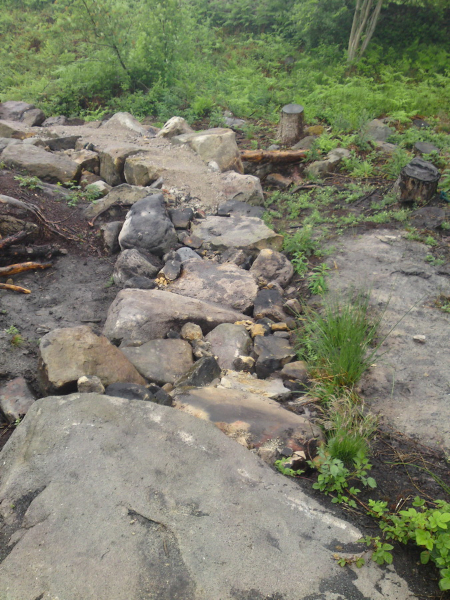
Work in progress...
In my naive and optimistic mind that was the descent line done, well almost, one day to shove some hardcore over the top of it I figured, then break out the bikes!
Yes?
No.
Not even close.
Because it turns out you don’t just “shove some hardcore on a trail”. You barrow it by the ton. With wheelbarrows, and your arms. Each barrow full might do 2 feet of trail, or often less.
So once more its a numbers game.
The hardcore was delivered to the very bottom of the hill. To begin with that seemed great, really near where we were working.
On the first day we got a good 40 yards or more covered, but it was a self defeating job.
The more we surfaced, the further up the hill we moved the work site, and the longer and more painful the push.
Dig days came and dig days went. Wet ones. Dry ones. Cold ones. Hot ones. We barrowed.
However with grim determination and the growing urge to put tyre to trail we made steady progress and in September 2010 the link was made and now, finally, it was time to get the bikes out and ride!
The new section comes as a sudden burst of technical rock riding at the end of a still gruelling gravity fuelled swoop-fest, and every time I branch off into it, and skit round the first off camber left hander, I think to myself, “Yeah… I did some of that!” Then I think “Shit my line! Tree stump! Rocks! More Rocks – Footwork!”
The opening of the new DL section was marked with a BBQ, some beers and huge sense of relief.
For me however it marked the beginning of an addiction. I had only done one day of “building” as I saw it, the rest was just pushing wheelbarrows full of stuff up a hill.
I didn’t mind that, it needed doing. But on that first day in March, as we crossed streams and moved huge boulders over to the trail to become “features”, I had got a taste for something I wanted more of. Gardening projects at home had borne this out. Family would ask why the path through the new rockery was so uneven and difficult to walk on…
My riding friends would take one look and know exactly why.
As winter drew in, the next dig days were spent carrying out repair work on bits of the red route and the top of the Decent Line.
This sort of work has since become the basic template of the volunteer days at Stainburn.
I should explain the word “repair”, to most people means “patch up”, “return to former state”, a metaphorical slap of paint. At Stainburn repair means “and now for something completely different”. Whatever the old bit is, it’s usually ripped out and something utterly new is put in to replace it.
I’ve honestly lost count of how many berms we’ve built in the last two years or stream crossings that became slightly excessive rollers.
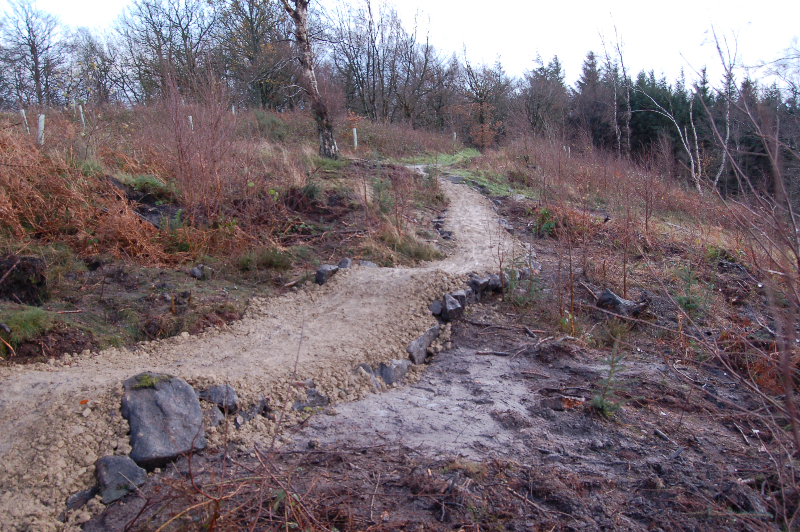
Evolution and cunning plans, building this was the first step to the new drop feature.
It is in this way that the red trails at Stainburn are now evolving.
In addition to this, alternate Black sections are sprouting out of the ground here and there (some are already all-but completed).
The Decent Line is sprouting more jumps. The Red, a new drop and other technical challenges.
This work feeds my addiction perfectly. We frequently complete a berm or a feature in a day. Gone are the months of endless barrowing.
Draw – dig – build – surface, can happen in one session, or for bigger things, two sessions.
There are a handful of projects currently at various stages of this process all over the hill. Wrap one up. Start another.
In addition to the “repair” work on the Stainburn side of the road, for three or four months last year we upped tools and moved across the road for the trail-building days.
The plan, to find, clear and redefine the natural informal trails that criss-cross the woods of Norwood. Many of these existed as fuzzy memories in the minds of those who’d been here long enough to remember them.
The gold climbs and descents were still there in part, but in others, all trace had been removed by the recent forestry work. Due to these being strictly informal trails we were actually able to work at an impressive pace. Armed with only rakes and a few brashing tools the lines were easy to find again and mark out with a combination of branches and bare earth. Only a few deviations were needed where the original trail was nowhere to be found.
That work in Summer 2011 gave birth to probably my favourite section of trails at Stainburn Forest. Niggley, demanding and challenging – the new natural woodland line has two entrances. One casual flowing entrance from the west, the other, a dastardly tight right-hander from the Purple technical line, which weaves between trees before joining its counterpart, with yet another steep tight corner that you can’t be sure you’ll clear, until you already have.
The line splits again almost immediately as you choose to go over or down a small slab.
Needless to say we had fun putting that bit together and even more when we rode it and found that it worked.
The result is an undulating traverse of one challenge after another, but still fundamentally Stainburn – you just won’t clean it end to end the first time.
As well as the rewarding and proud feeling of riding trails you’ve built with your own hands and being able to shout over your shoulder to your mates “I did this bit”, there have been the laughs, giggles, ruthless mockery and mucking about that comes from a team of people working together on something they enjoy. As well as a fair amount of standing about drinking coffee and talking about bikes. We’re only human after all.
And yet, even while all his is going on, the scheming minds behind the Stainburn Trail-building effort are looking at maps and drawing speculative lines on them and often drawing them on the ground as well.
They are planning what will come over the next year.
If you see a pair of lines drawn in spray paint leaving the trail, that there, is the tell tail mark of a cunning plan.
The trails and the ambition of the trail team are not the only thing at Stainburn that has been growing. The trees have also been getting ambitious.
In the last 2 years what were just saplings have leapt forward and are now over 6 ft tall.
The harsh winds and driving rain that once battered the Stainburn hillside, that helped erode the original surface of the Descent Line, won’t be doing so any more.
New woods are establishing themselves. Where once you could look down from the car park as I did two years ago and see the entire descent line mapped out below, now, most of it is hidden from view. With the shelter of this new foliage, what we build on this hillside this year, will last a very long time, whilst also being dryer and less vulnerable to the persistently erosive effects of mother nature.
As I sit here and tot it all up, it amazes me, so much has been done in the last two years and I’m almost certainly forgetting bits. My hunch, however, is what gets done in the next two years will dwarf it.
I’m beginning to get a few cunning plans myself. It cannot be helped after a while. It becomes impossible to walk through woods without mentally drawing trail into the hillside, or past a heap of rocks without thinking how useful they could be.
The same spade I used two years ago has become my trail tool of choice. The gloves have long since worn out from lifting and carrying hundreds of rocks and the hours of work.
I’ve also learned a little perspective and a hint of patience. I say we get to do things quickly now, but that’s only because many have come before us and done things slowly. From the initial discussions with the FE to the funding applications. From the first bit of the Warren Boulder Trail to the year before I even showed up, putting in most of the descent line extension – sometimes just five guys, in the rain, on a hill, on their own.
Many have come before me and done a lot of the boring bits.
Trail centres don’t just happen.
For all the effort and the cost, what they mostly take is time, in every way.
Often this is the time of volunteers.
Volunteers like the chaps who run SingletrAction, who smooth out the issues of bureaucracy and red tape, and the time of the volunteers who show up in all weathers, to heave rocks, push barrows, dig holes, swing axes, clear trail-bed, battle roots and tree stumps, roll boulders, pitch stone, angle berms, drink tea, and talk about bikes.
If you’re interested in joining SingletrAction check out the membership page.
Trailbuilding days happen monthly at Stainburn, Dalby, Guisborough and with our friends at PBMA Gisburn. See the Days & Events pane on the right of this webpage.

